Ask a question from expert
ITC571 Emerging Technology & Innovations Assignment
22 Pages6864 Words113 Views
Emerging Technologies and Innovation (ITC571)
Added on 2020-05-16
ITC571 Emerging Technology & Innovations Assignment
Emerging Technologies and Innovation (ITC571)
Added on 2020-05-16
BookmarkShareRelated Documents
Full NameJATIN MUKHIJAStudent ID11615957SubjectITC571 – Emerging Technology and InnovationsAssignment NoAnnotated BibliographyDue Date12/01/18Lecturer’s NameMalka N. HalgamugeEmerging Technologies and Innovation: EmployeeManagement System for ABCJATIN MUKHIJA Jatinmukhija7@gmail.comCharles Sturt University, Melbourne, VictoriaGRAPHIC ABSTRACT
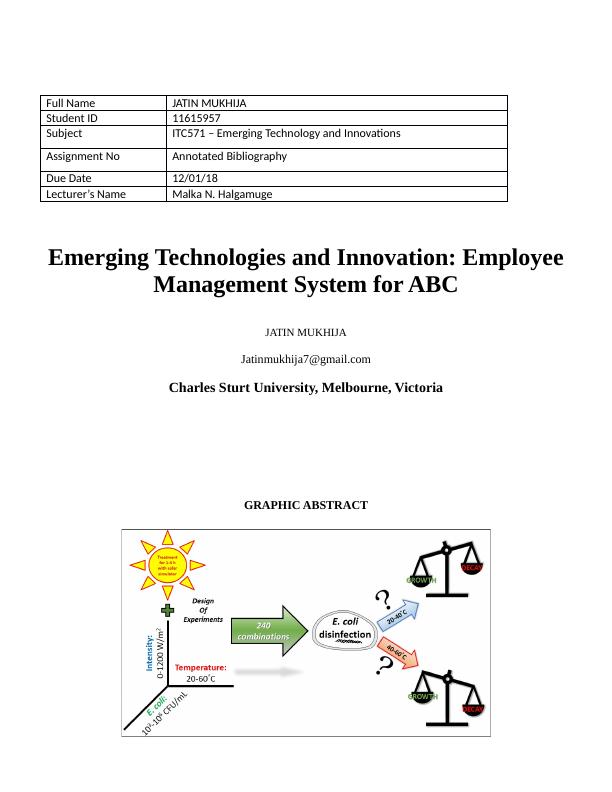

ABSTRACTThis paper proposes a system for automatically evaluating and ranking candidates for human resource hiring applications by the ABC Corporation, using machine learning algorithms. The proposal was informed by the tedious process of manual selection and scoring of possible candidates by human subjects, a process that is both tedious, inconsistent, and prone to subjective bias. The research was done through an experimental setup where past scoring was used a s the training data set for the ‘learning to rank’ algorithms. The system was set up and tested against human scoring fr a data set of one hundred candidates that were selected using Google Blog API and had a Linked In profile as well as a blog. In total, 100 candidates were used as the sample size. The scoring correlation coefficients were analyzed using the Pearson correlation coefficient and a high positive correlation coefficient of 0.87 was established, showing that the proposed model that makes use of machine learning algorithms offers a novel approach to automatic ranging and scoring in e-recruitment, with consistent, accurate results. KEYWORDSOnline recruitment, e-recruitment, data mining, personality mining, recommendation systems
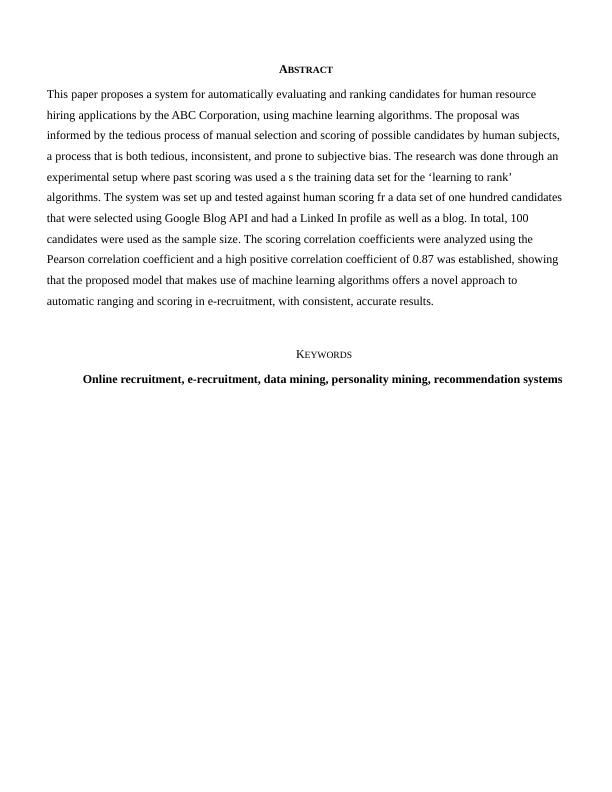
ANNOTATED BILIOGRAPHY Anrah, E., & Sokro. (2012). Human resource information system as a strategic tool in human resource management. Problems of Management In The 21 St Century, 2(1), 7-14.Keywords: Decision Making Contribution, Quality Information Effects, Cost and Time Savings, Human Resource Information Systems (HRIS)Section1: Significance of the ResearchThe study identifies how HRIS contribute to effective strategic human resource management and itsstrategic importance at the workplaceSection2: Originality of the ApproachUses a correlation analysis between HRIS (Independent variable) and other dependent variables, namely Decision-Making Contribution, Quality Information Effects, Cost and Time Savings. Section 3-4: Literature ReviewIt is important that the effectiveness of HRIS in effective HRM is investigated and understood; the authors used a primary survey research with participants from various companies and found that HRIS enhanced HRM through reduced costs, time savings, and better decision making with regard to HRM. HRIS enables efficient planning HRMSection 5: Research GapIt acknowledges the value of HRIS in effective HRM but fails to define how such a system should be designed and what its components should beSection 6: Aim of ResearchThe proposed system will have an integrated system for automatic employee management starting from recruitment, attendance, performance appraisal, to promotion and employer retention using big data analytics and cloud based systems with mobileFaliagka, E., Tsakalidis, A., & Tzimas, G. (2012). An integrated e‐recruitment system for automated personality mining and applicant ranking. Internet Research, 22(5), 551-568. http://dx.doi.org/10.1108/10662241211271545Keywords: Human resource management, Recruitment, Selection, Data mining, Personality, Social networking sites, E‐recruitment, Recommendation systems, Personality mining, Analytic hierarchy processSection 1: Significance of the ResearchThe system demonstrates how recruitment can be done automatically through an online portalSection 2: Originality of the Approach
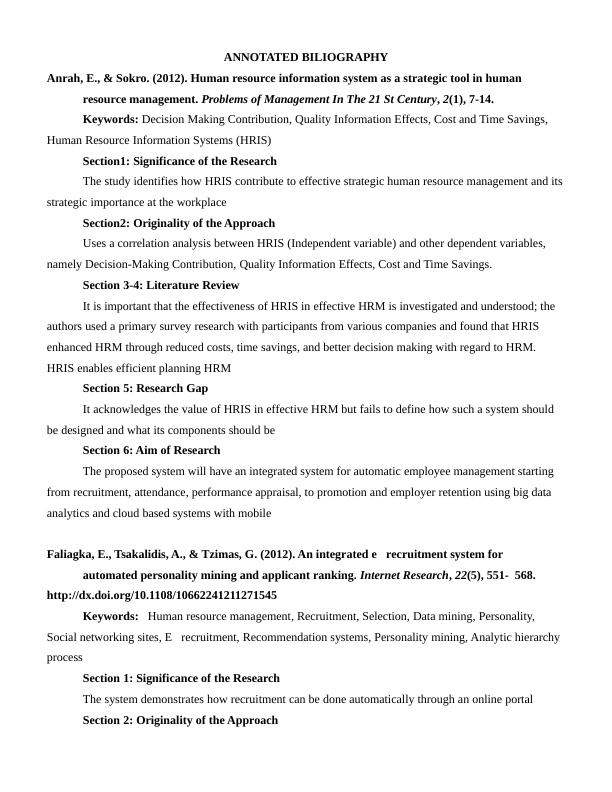
The system uses automated online recruiting and ranking system that eliminates bias in recruiter decision making Section 3-4: Literature ReviewBias in recruitment hampers effective talent recruitment; further, pre-screening of applicants can be time consuming. The proposed system solves these problems through automated Pre-screening of applicants. Candidates apply online and automatically ranked for effective decision making during recruitment. The system performance was tested and results showed its comparable to human recruitment, with the exception of senior management positions Section 4: Research GapDelves only on recruitment using an online portal and ineffective for senior positions Prescreening and automatic rankingSection 5: Aim of ResearchProposed system to incorporate all aspects of employee managementKadry, S., & Smaili, M. (June 01, 2010). Wireless attendance management system based on iris recognition. Scientific Research and Essays, 5, 12, 1428-1435.Key words: Iris recognition verification, biometrics, personal identification, attendance management, wirelessSection 1: Significance of the ResearchThe research proposes a new and unique method for employee attendance management that does not require any input and is highly accurate. It utilizes a very highly personal biometric identification system Section 2: Originality of the ApproachThe use of an automated iris scanner that does not need input from users and captures real time data accurately. Section 3-4: Literature ReviewThe researchers propose and test a wireless system that recognizes the biometric feature of the human iris. The system was tested to be highly accurate, affordable, and practical; it avoids the need for setting up attendant networks for biometric identification and solves the spurious attendance problem Section 5: Research GapThe developed system is novel; however, it is only one aspect of employee management and does not provide a way for managing other employee data, such as productivity for use in decision making Section 6: Aim of Research
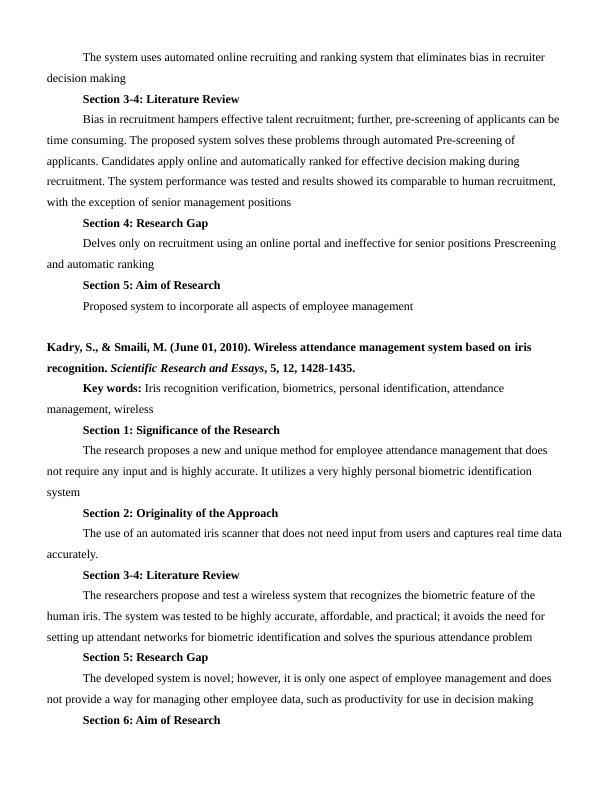
The proposed research aims at having a system that captures productivity data in order to help makedecisions on such matters as employee training and promotion Naim, I., Tanveer, M. I., Gildea, D., & Hoque, E. (n.d.). Automated Analysis and Prediction of Job Interview Performance. Ieee Transactions on Affective Computing, 1.Keywords: Interviews, Videos, Feature extraction, Context, Robots, Electronic mail, YouTube Section 1: Significance of the ResearchInterviews are aimed at getting the best suited persons for a job; however, this is not usually achieved because judgment of ability can sometimes be too subjective. The researchers propose a method for predicting job performance based on in-interview factors and features of the would-be employee Section 2: Originality of the ApproachThe approach is highly original in using algorithms that decode facial features and expressions during interviews; it takes into consideration both verbal and nonverbal behaviors and helps in decision support systems. Section 3-4: Literature ReviewThe researchers sought to develop a novel system for HR to make accurate decisions of staff to be employed using a computerized system that evaluates language, body expressions, and prosody during interviews. Using an experimental set up, the researchers analyzed recorded videos from 138 interview sessions of 69 persons seeking internship positions. The authors established that their system can accuratelypredict interview ratings using several metrics, with correlation coefficients 0.75 or higherSection 5: Research GapThe system deals with one aspect of employee management, and that is interviewing and predicting outcomes and performance. Section 6: Aim of ResearchThis proposed research aims at developing an integrated system that manages employee informationthrough the employee life cycle, from recruitment to attendance and performance Parisio, A., & Neil Jones, C. (2015). A two-stage stochastic programming approach to employeescheduling in retail outlets with uncertain demand. Omega, 53, 97-103. http://dx.doi.org/10.1016/j.omega.2015.01.003Keywords: Decision making/process, Scheduling, Stochastic programming, Decision support systems, Operational/OR Optimization, Integer programming, Resource managementSection 1: Significance of the Research
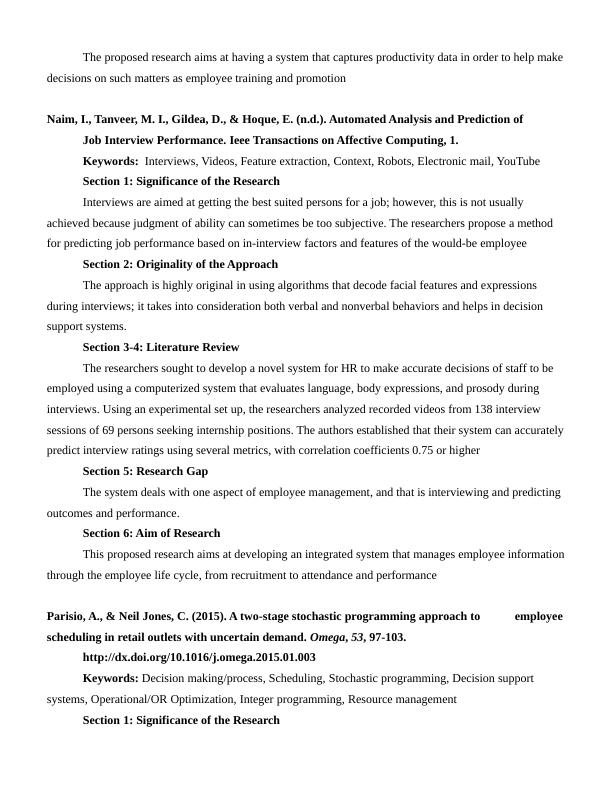
End of preview
Want to access all the pages? Upload your documents or become a member.